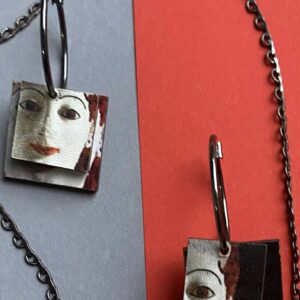Σκουλαρίκια εμπνευσμένα απο την Πεπλοφόρο Κόρη
Υλικό ξύλο, κρίκος χειρουργικό ατσάλι.
Μήκος 5 εκ.
Πλάτος 2,5 εκ.
Earrings inspired from Peplos Kore
Materials wood, stainless steel.
Length 5 cm.
Width 2,5 cm.
38,00 €
Δωρεάν Μεταφορικά για αγορές άνω των 50€
The Story
Η Πεπλοφόρος Κόρη
Το κάτω μέρος του σώματος βρέθηκε το 1886 στον ονομαζόμενο «λάκκο των Κορών», το κεφάλι λίγες μέρες αργότερα σε κοντινή απόσταση και το πάνω μέρος του σώματος ανατολικότερα, στα βορειοδυτικά του Ερεχθείου.
Η Κόρη είναι γνωστή ως «Πεπλοφόρος» εξαιτίας του ρούχου που φορά, του πέπλου. Ο πέπλος συγκρατείται στη μέση με ζώνη και στους ώμους με μεταλλικές περόνες, στερεωμένες στις μικρές οπές που υπάρχουν ακόμα. Από κάτω φορά μακρύ χιτώνα με λεπτές πτυχές, που απλώνονται πάνω στα πόδια. Οι φασματοσκοπικές αναλύσεις των χρωμάτων έδειξαν ότι η ζώνη θα ήταν μπλε και πράσινη και ο χιτώνας γαλάζιος με πράσινη ταινία στον λαιμό. Ο πέπλος ήταν λευκός, με το μεσαίο τμήμα του διακοσμημένο με κατακόρυφες σειρές μικρών ζώων, πουλιών και ιππέων μέσα σε κόκκινα πλαίσια. Τα πλαίσια ορίζονταν από δύο ταινίες με ανοιχτόχρωμους ρόδακες, ίσως σε πράσινο φόντο. Στην αναδίπλωση και στον ποδόγυρο του πέπλου υπάρχει διπλή ταινία διακοσμημένη με συνεχή σπείρα και ζεύγη φύλλων και με αλυσίδα από έλικες και ανθέμια, που εναλλάσσονται με άνθη λωτού.
Peplos Kore
The lower part of the body was found in 1886 in the so-called “Korai Pit“, the head was found near by a few days afterwards, and the upper part of the body was located a little to the east, northwest of the Erechtheion.
The Kore has been named the “Peplos Kore” due to the garment she wears – the peplos. The peplos was fastened in the middle with a belt and on the shoulders with bronze pins which were secured in the small holes that are still preserved. Beneath her peplos, the Kore wears a longer chiton, whose slender folds encase her legs. Spectrographical analysis of the colours have shown that the belt was once blue and green and the chiton blue, with a green band at the neck. The peplos was white – its middle section decorated with vertical rows of small animals, birds and riders shown on squares of red framed by bands of colourful rosettes on a green background. The peplos borders were decorated by a double band with spirals, floral elements and a chain of volutes and palmettes alternating with lotus flowers.
The Kore’s hair falls over her shoulders in long curls, while behind, it is fastened with a ribbon. The red paint that covers the hair today is an undercoat over which the final brown colour was applied. The same red hue covers the irises of her eyes and her lips, while her pupils, eyelids and eyebrows were probably highlighted with black paint. Traces of metal rods are preserved in the 35 holes located on her head which supported a stephane of light rays or lotus flowers. Small holes in her earlobs indicate that she was once wearing bronze earrings and a stem projecting from the top of her head is a meniskos.
The Kore’s left hand was made out of a separate piece of marble and fitted into the notch still preserved nowadays. Her right hand extends downwards and she is clasping her fingers as if she was holding something. This in combination with the conservative for her time clothing, lead many to assume this is not a simple Kore, but a goddess – perhaps Artemis, who would have been gripping arrows in her right hand, and a bow in her left. This statue is the work of an important Athenian artist, perhaps the same one who crafted the “Rampin rider” (Ακρ. 590) and the statue of a hunting dog.
Σκουλαρίκια εμπνευσμένα απο την Πεπλοφόρο Κόρη
Υλικό ξύλο, κρίκος χειρουργικό ατσάλι.
Μήκος 5 εκ.
Πλάτος 2,5 εκ.
Earrings inspired from Peplos Kore
Materials wood, stainless steel.
Length 5 cm.
Width 2,5 cm.
 Kore in details earrings
Kore in details earrings